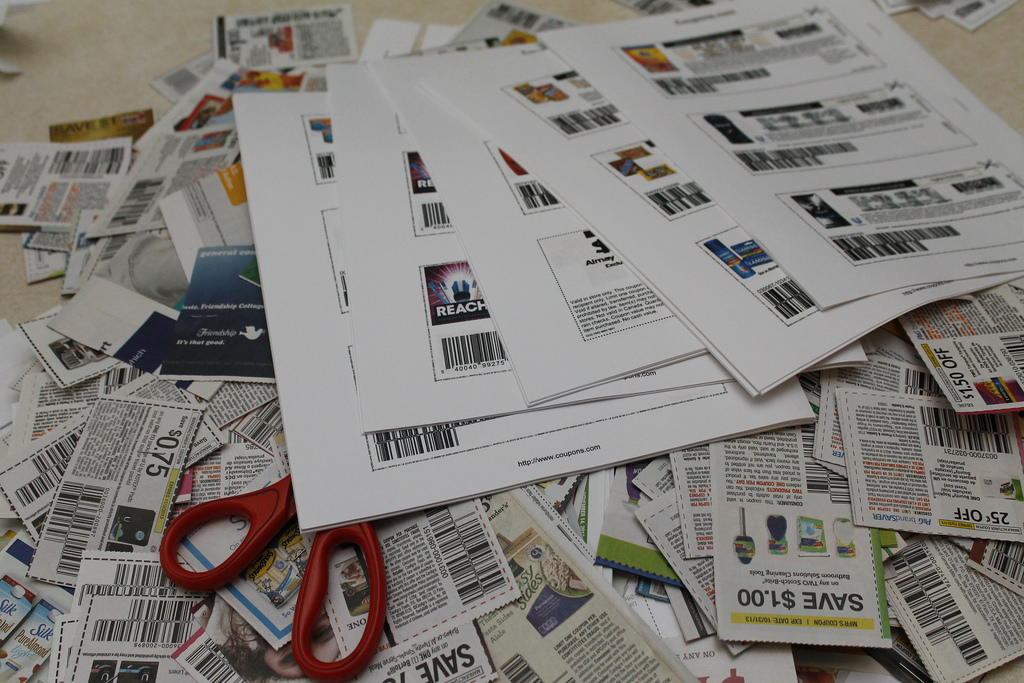
A new analysis of coupon trends over the past year presents a position that’s decidedly different from others, who have downplayed the decline in overall coupon use while playing up the rapid rise of digital coupons. The new report claims the two phenomena are interrelated, and not necessarily in a good way – coupon use is down, because there are more digital coupons available than anyone actually cares to use.
That take comes from NCH Marketing Services, the coupon processor owned by Valassis, which also publishes the RedPlum coupon inserts.
Like its coupon processing competitor Inmar, which released its own 2017 analysis earlier this month, NCH noted that 2.07 billion coupons were redeemed last year, down 9.2% from the previous year. And like Inmar, NCH noted that digital coupon use continued to climb, representing nearly 12% of all coupons redeemed in 2017.
Inmar’s take? “While promotion investments are resulting in lower redemption rates,” Inmar Chairman and CEO David Mounts told Coupons in the News, 2017 “will be remembered for a long time as the point when many shoppers absolutely shifted to a pure digital preference.”
But NCH took some other numbers into consideration before rendering its verdict. It noted that marketers shifted more of their coupon volume from paper to digital last year, driving a 27% increase in digital distribution. As you might expect, more digital coupons led to an increase in digital coupon redemption. But that increase was not large enough to offset the corresponding decrease in paper coupon use.
Therefore, NCH concluded, the decline in overall coupon use last year was due largely to the fact that marketers shifted more of their coupons from paper to digital – and not enough consumers made the same shift.
“It’s all about the right media mix,” NCH Vice President of Marketing Charlie Brown told Coupons in the News. “In order to allocate for digital and not experience a decline in redemption volume, there must be sufficient print reach – in-store handouts and on-pack, FSI and direct mail.”
Digital is certainly growing in popularity. But last year, it appears to have been more popular among coupon issuers than it was among coupon users. “Marketers who rely too heavily in one direction versus another have missed an opportunity to maintain their reach and activation of shoppers on the whole,” Brown said.
Some may consider paper coupons delivered in the Sunday newspaper to be anachronistic these days, but the format still dominates by far. FSI (free-standing insert) coupons “represented 93.7% of coupon distribution volume and was the top media format for redemption volume as well,” NCH pointed out.
NCH also noted that its 2K17 Coupon Intelligence Report released last year found that shoppers said their most preferred way to obtain coupons was through the mail.
The mail! How’s that for anachronistic?
Second choice was actually a tie – 37% said they liked getting coupons from newspaper inserts, while 37% preferred digital load-to-card coupons.
So NCH’s point is, while there’s a clear demand for digital coupons, there’s still plenty of appetite for paper coupons. And marketers who move too quickly to digital risk alienating these paper coupon fans, resulting in fewer shoppers redeeming their coupons and buying their products.
It’s worth noting that NCH’s business model relies on the continued redemption of printed coupons, so it’s in the company’s best interest to encourage marketers not to give up on paper. Inmar, which is heavily invested in digital coupons, has a different take. Then there’s Quotient, owner of Coupons.com, which is entirely digital – so it has a different take, too.
“2017 saw an unprecedented focus on digital by CPGs (consumer packaged goods companies) and retailers,” Quotient CEO Mir Aamir told investors this week. “And really, there’s a lot of very good momentum in retailers and CPGs to move faster to digital.” In fact, Quotient says more manufacturers are leaving paper behind altogether. “We have mentioned in the past that we did see some brands go pure digital,” Aamir said. “We are seeing more do that. And then we are hearing from, and planning with, several CPGs to shift more dollars out of FSI into digital – that continues.”
Aamir mentioned almost in passing that the use of Coupons.com printable coupons – which are sort of digital and sort of paper – was roughly the same in 2017 as it was the previous year, while pure digital coupon use continues to climb. Printable coupons were once Quotient’s bread and butter, but they now represent a smaller part of the company’s offerings. Even so, Quotient isn’t ready to declare them dead just yet – like Inmar just did.
2017 marked “the demise of print-at-home coupons,” Inmar declared last week, in contrast to what Quotient just reported. The format “began to fade into the sunset” as “more shoppers have abandoned their printers”.
When asked its take on printables, NCH staked out a middle ground. “Print-at-home is an important part of a balanced media mix plan to reach a segment of consumers who don’t shop at stores that enable paperless coupons,” Brown said. But as more retailers make digital coupons available on their websites and apps, fewer are hosting printable coupons on their sites, making printables somewhat more difficult for the average shopper to find. “This has had an effect on the total redemption market,” Brown said, even though “print-at-home coupons redeem on average at twice the rate of a paperless coupon.”
So when it comes to digital’s rise, printables’ decline and the continuing slump in overall coupon use – the numbers don’t lie. But the meaning behind those numbers is open to interpretation. Analysts can spin the data to help support their conclusions, as marketers make their best guesses as to what types of coupons will generate the best return on investment. Ultimately, though, it’s coupon users themselves who will determine whose predictions about the future of coupons will pan out.















